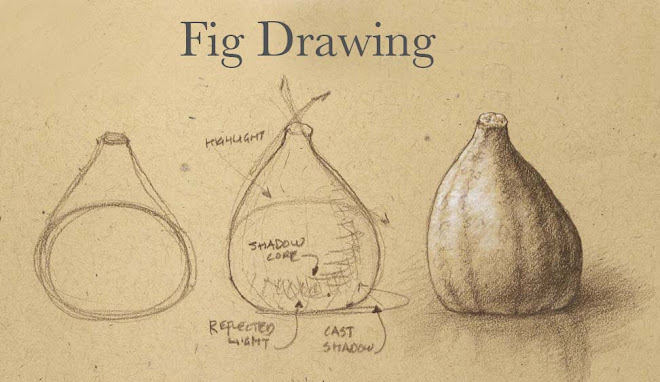
We 'read' the faces of our fellow humans in greater detail than anything else we look at - we see endless, fascinating things in the expressions that flicker across someone's face. If only we could read elbows and bellies, and shadows and sunsets, as deeply - we would all be mystics and saints!
We want to immediately draw the parts of the face that interest us - the eyes, of course, and the mouth and nose - and tend to ignore everything else, but we need to understand, as ever, the whole form, and how the whole shape works together.
We should see the head, the shape defined by the skull, as a ball, the shape that roughly encompasses the brain. And attached to this is egg shape of the face, where all the interesting parts - the eyes and and eyelashes and lips and so on - are arranged.
Like every part of the body - the body as a whole - understanding the proportions is the key to the whole matter. I even suggest in this instance rote memorization - copying charts such as I've drawn here, until you can do it in your sleep, and then experience the joy of seeing how the real world - the actual heads and faces we encounter in life - follow and diverge from the system.
In drawing the 'egg' of the face, one first divides it down the center north pole to south pole, and then the equator. The equator line is where the eyes fall - right smack dab in the middle of the head. This at first seems to grant people far more forehead than seems right, but if you look you'll see that faces are all scrunched down in that lower half of the head - when we begin drawing we for some reason cheat people out of their fair share of brain cases.
The next division is a leap of faith, but it works, I swear - indicate the hairline on the egg of the face, and then divide the distance from the hairline to the jaw in three parts - this gives us the brow and the bottom of the nose. And even with just these marks indicate we begin to have a compelling face. Try it, it works.


You see here I used the same proportions to draw Beethoven and a 40's actress, and the same proportions hold for Ernest Borgnine and Bertolt Brecht and Ella Fitzgerald - a wide (infinite!) array of faces, all built on the same schema.
The features themselves bear being practiced in isolation. I'll do a deeper posting about each of these individually, but for now I'll note that we tend, when we first begin to draw, to adopt a series of naive symbols for each of the features which in truth blinds us to what they actually look like. The eyes are often drawn as two arcs joined together, horizontally symmetrical, when in fact the shape of the eye is far more complex - always, when you draw the eye, try to remember how it is a ball in a socket, with folds of flesh (the lids) wrapped around it.

I think of the lips as two 'M's' and a 'W.' An elongated 'M' forms the upper shape of the lip, and second, generally more shallow 'M' forms the line of the mouth, and then an elongated 'W'
forms the lower lip - what is the relationship between the shapes? That is what makes each individual mouth unique.

And the ear! Again, we'll look at it in greater depth later, but look at, and commit to memory, the parts:
- The helix, the 'C' shaped piece of cartilage that gives the overall shape to the ear
- The anti helix, the major shape contained within the helix, which branches at the top
- The conch, a smaller 'C' shape that encompasses the passage into the ear canal
- The tragus, the little ridge that protects the other side of the ear canal
- and everyone's favorite, the lobe.


